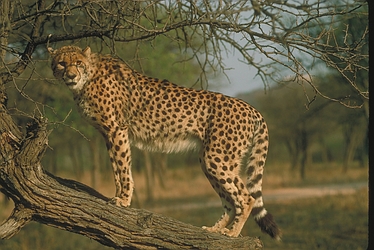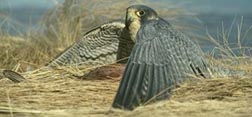Evolution Explained
Fast Food
Man Eaters
Sixth Sense
Same Difference
Do your Part
Click here for profiles on your favorite animals!
Click here for the animal trivia section. Winner gets a prize! Give it a try!
Click here for the Awards that Amazing Animal Articles has won!
Fast Food
by David A. Rizwan
Many animals use speed to catch their prey. From the air to the ground you and I stand on, animals based on speed to catch prey are present. Why do these animals apparently from different niches all use the same technique to catch their prey? We shall attempt to find this out.
Land
 Most people are familiar that the cheetah is the fastest mammal on earth. But not many people are familiar with why this is so. The cheetah is anatomically built for speed. Under his eyes, the cheetah has a black stripe, which actually shields his eyes from the hot sun. In fact, football players have adapted this by painting themselves with black paint under their eyes. This allows the cheetah to see perfectly to scout out its prey. Next, the cheetah takes an elusive position in the brush around the herd of small hoofed animals, such as the Thomson's gazelle and the springbok. The cheetah peers until he finds desirable prey. Once he has accomplished this, he more or less runs at that single animal. Cheetahs can read speeds in excess of 60 miles per hour in just a little over 3 seconds, comparable to a sports car. His long legs and flexible spine are the keys, along with a long tail, long claws, and a slender build, to how this is accomplished. Their spine is so flexible that when they run, their back legs actually reach farther than the front legs. The cheetah then catapults itself up again and continues this for the duration of the chase. The long legs of the cheetah allow it to have a longer stride. In fact, the cheetah often is not touching the ground at all. At full speed, this actually gives the cheetah up to 20 feet between steps. By the time the prey finally sees the cheetah, he has already reached a full speed. However, the small game that makes up the cheetah's prey has developed to "outplay" the cheetah at his own game. The springbok, which can run very fast as well, has agility. Since cheetahs are very fast at running linearly, the best idea is not to just run away, but to run away while zigzagging. If you ever see a cheetah hunt, you will be amazed at how this "game" is actually played. More often than not, however, the prey successfully outruns the cheetah by basically outlasting them with agile movements. As fast as cheetahs are, they have no stamina and can only continue a chase for a few hundred yards. Even if they do successfully kill the prey, they cannot eat it right away. They have to wait 30 minutes to catch their breath first!
Most people are familiar that the cheetah is the fastest mammal on earth. But not many people are familiar with why this is so. The cheetah is anatomically built for speed. Under his eyes, the cheetah has a black stripe, which actually shields his eyes from the hot sun. In fact, football players have adapted this by painting themselves with black paint under their eyes. This allows the cheetah to see perfectly to scout out its prey. Next, the cheetah takes an elusive position in the brush around the herd of small hoofed animals, such as the Thomson's gazelle and the springbok. The cheetah peers until he finds desirable prey. Once he has accomplished this, he more or less runs at that single animal. Cheetahs can read speeds in excess of 60 miles per hour in just a little over 3 seconds, comparable to a sports car. His long legs and flexible spine are the keys, along with a long tail, long claws, and a slender build, to how this is accomplished. Their spine is so flexible that when they run, their back legs actually reach farther than the front legs. The cheetah then catapults itself up again and continues this for the duration of the chase. The long legs of the cheetah allow it to have a longer stride. In fact, the cheetah often is not touching the ground at all. At full speed, this actually gives the cheetah up to 20 feet between steps. By the time the prey finally sees the cheetah, he has already reached a full speed. However, the small game that makes up the cheetah's prey has developed to "outplay" the cheetah at his own game. The springbok, which can run very fast as well, has agility. Since cheetahs are very fast at running linearly, the best idea is not to just run away, but to run away while zigzagging. If you ever see a cheetah hunt, you will be amazed at how this "game" is actually played. More often than not, however, the prey successfully outruns the cheetah by basically outlasting them with agile movements. As fast as cheetahs are, they have no stamina and can only continue a chase for a few hundred yards. Even if they do successfully kill the prey, they cannot eat it right away. They have to wait 30 minutes to catch their breath first!
Air
Many people are under the impression that the cheetah is the fastest animal on Earth. However, the true fastest animal on Earth is actually airborne. The peregrine falcon can fly so fast, that normal birds cannot even breathe when going half as fast. Like the cheetah, the peregrine's hunting style is also specifically structured for speed. The falcon consumes mainly birds, so most of its hunting is done in the air. The falcon flies high up above its prey in preparation for its attack. When the falcon is ready to mount his attack, he positions his wings very similar to those of a jet plane, and flies down from up above. His great speed and streamlined shape, combined with gravity allows the bird to dive at speeds in excess of 200 mph! That's the speed a racecar on a speedway! The prey is then knocked out of the air. If the initial impact does not kill the prey, the fall certainly will. The small peregrine falcon can than just swoop down and feed upon his kill whenever he wishes. (see right)
For a bird with such a great speed and hunting style, you would think that this bird would be untouchable. However, during the 1940's, people were having trouble with mosquitoes and the spread of malaria. Soon enough, a new pesticide called DDT came into use. The pesticide was so effective that the creator won the Nobel Peace Prize. His creation killed mosquitoes at a high rate and saved millions of people worldwide. However, as all chemicals eventually do, the chemicals made it into the ecosystem. The chemical eventually made it into the birds, where it caused birds to lay soft eggs that would break as the parents tried to incubate them. Luckily, DDT was banned in the United States in the 1970's, but its use is continued throughout the world. Now biologists had to create a way to bring the species back. Ironically, they looked toward the big cities to keep these birds. The tall skyscrapers replaced cliffs, where nesting occurs, and there was an endless supply of pigeons for the falcons to eat. Thanks to this creative idea, the peregrine falcon is making a comeback.
As we have observed, speed is a valuable asset to many predators, and their prey alike. However, the most important issue that rose up during this discovery was the issue of pesticides. Never use pesticides. Instead, search for biologically friendly alternatives; such as ladybugs, traps, or other natural ways to control pests, this is called. Even adding pest repelling plants, such as basil, chives, mint, marigolds, and chrysanthemums can help you in preventing various pests from making a snack out of your garden.
